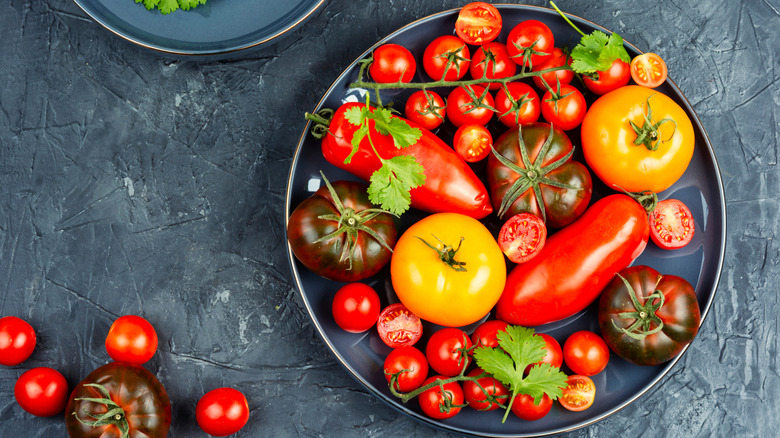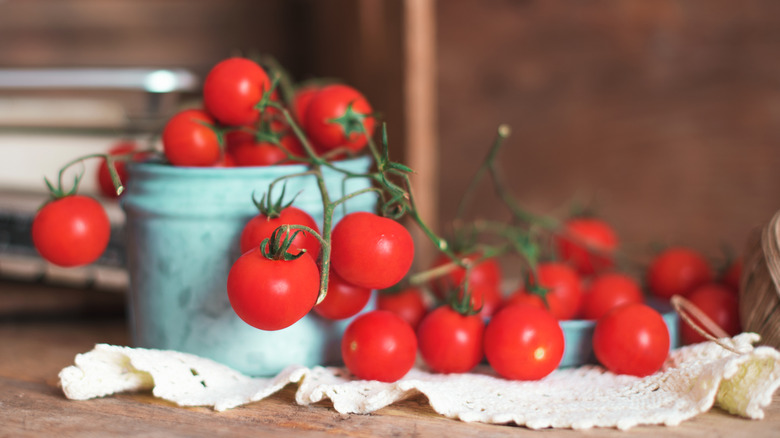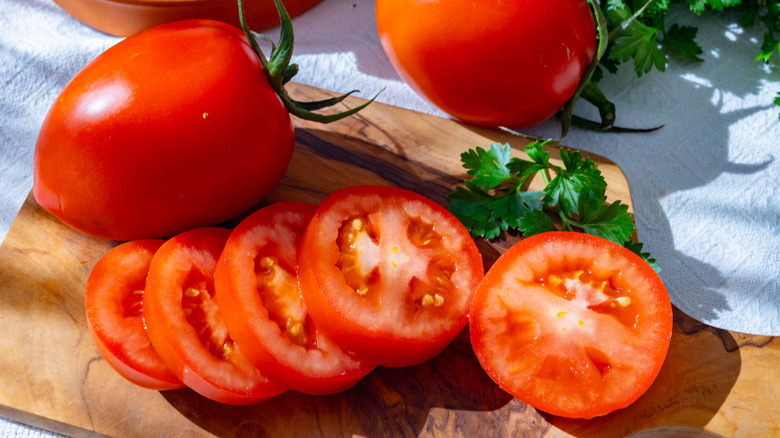Cherry Vs Roma Tomatoes: What's The Difference?
Tomatoes are culinary powerhouses; they're the heart of Mexican salsas, Italian sauces, and countless dishes in between. Grown with love all over the globe, they're anything but basic. In fact, there are over ten thousand different varieties worldwide, with new ones being developed by farmers and gardeners every year. Tomatoes come in a stunning array of shapes, sizes, and colors (some even feature unique patterns). Each variety features its own distinct flavor, texture, and culinary uses. In U.S. grocery stores, cherry and Roma tomatoes are among the most common and widely used types. Both are versatile kitchen staples packed with plenty of flavor, yet they serve very different roles. Cherry tomatoes are sweet, small, and juicy — perfect for snacking on, tossing in a salad, or roasting whole. Roma tomatoes, on the other hand, are firm, meaty, and low in moisture, making them perfect for cooking pasta sauces, stews, or any dish that requires structure and depth.
Choosing the right tomato can make a big difference. Some will burst in your mouth with fresh, tangy sweetness, while others can hold their shape when baked in a lasagna or a pasta bake. Using the correct type can mean the difference between a watery or rich pasta sauce, or give your Caprese salad a bright, balanced finish instead of a dull one. Whether you're a seasoned home cook or just trying to level up your weeknight dinners, learning when to use cherry tomatoes versus Roma tomatoes is a simple step that will have big results.
What are cherry tomatoes?
Cherry tomatoes are the darlings of the tomato world. Small and round, they typically come in vibrant hues of red, orange, or yellow. What sets them apart is their crisp skin, juicy interior, and naturally sweet flavor. Compared to Roma tomatoes, their smaller size, higher water content, and delicate texture make them ideal for snacking and enjoying raw, which is how they're usually sold.
Each bite delivers a mini flavor explosion of brightness and sweetness, making them especially refreshing — so it's no wonder why the Mediterranean is obsessed with them (aside from owing their creation to two Mediterranean countries, Greece and Israel), where their fresh and juicy flavors shine in simple, summer dishes. While they're available year-round, cherry tomatoes taste best when they're fully ripe and in season, which is typically during the hottest months of the year. When they've been fully ripened on the vine, they develop more umami, giving them an extra layer of complexity.
Cherry tomatoes are best raw, adding a touch of vibrant color alongside a sweet burst of flavor. Their satisfying texture and taste complement fresh, herbaceous ingredients, making them perfect for light, no-fuss salads. For example, they pair beautifully with creamy mozzarella and aromatic basil like in a classic Italian Caprese (you could sneak in juicy stone fruits for a sweet surprise), or alongside refreshing cucumbers, red onions, briny olives, and feta in a Greek Salad.
They're also excellent grilled in a kebab. When lightly charred, they develop a smoky, concentrated sweetness that pairs perfectly with grilled meats or white fish.
What are Roma tomatoes?
Despite their name, Roma tomatoes, also known as plum tomatoes, are an American invention — and are the sauce heroes of the tomato world. Typically deep red with a plump, oval shape, they're larger and more elongated than cherry tomatoes. In grocery stores, you'll find them sold both raw and canned — and each comes with its own advantages. Though they are typically less sweet than cherry tomatoes, raw Roma tomatoes offer a fresh flavor that develops beautifully in slow-cooked dishes. While there is debate about fresh-versus-canned for sauces, canned Roma tomatoes are a convenient shortcut that sees the tomatoes pre-peeled and packed into tomato juice or puree — chopped or whole — for quick, flavorful sauces, especially if you pick one of our top-ranked brands.
What makes Roma tomatoes stand out is their dense meaty flesh, low moisture content, and chewy texture. Unlike cherry tomatoes, they don't explode with juices when bitten into, which makes them less ideal for snacking on but perfect for cooking. Their lower moisture content means that they won't water down your dishes, and they hold up well under high heat. This makes them ideal for hearty pasta sauces, tomato pastes, and stews. Beyond sauces, Roma tomatoes thrive in soups, where their flavors intensify as they are roasted and blended.



